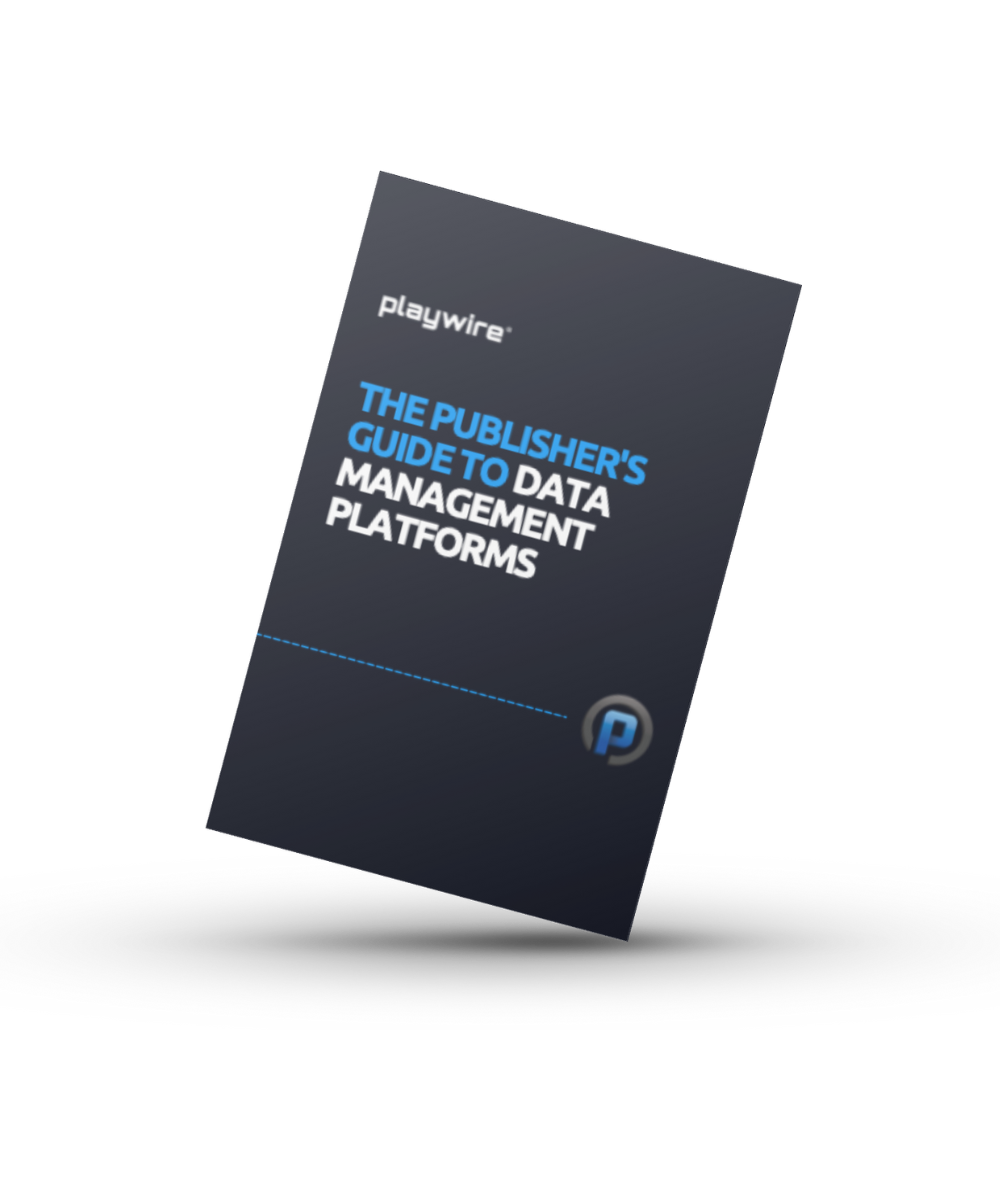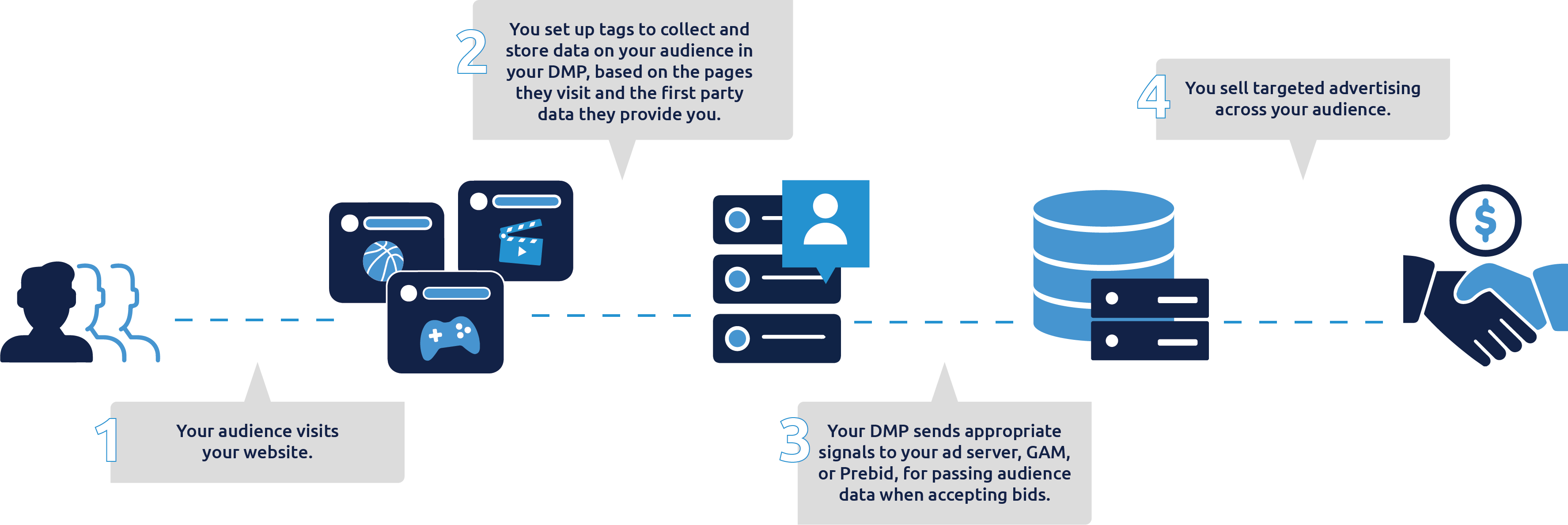The Publisher's Guide to Data Management Platforms
Get a PDF copy of the guide using the form below, or scroll down to read the entire guide right on this page.

Don't Have Time To Read the Entire Guide Now?
We'll email you a downloadable PDF version of the guide and you can read later.
All of our content is generated by subject matter experts with years of ad tech experience and structured by writers and educators for ease of use and digestibility. Learn more about our rigorous interview, content production and review process here.
Built with the expertise of:
INTRODUCTION
As you grow as a publisher, a Data Management Platform (DMP) becomes a more and more important part of your ad monetization strategy. Why? Because data is a publisher’s most significant ally, however, without the proper technology and a proper understanding of how to use the data you’re collecting to better inform the choices you make with both your content and your advertising strategy, your data is essentially useless.
Like any piece of ad tech, there are a lot of moving parts when it comes to selecting and implementing a DMP. You have to consider what kind of data is available to you and the best strategy for utilizing it.
Doing so takes a bit of trial and error and a whole lot of testing as well as constant management as you build out audience segments based on your data collection. And truthfully, none of this matters if you don’t have the proper consent tools in place to assure you remain in compliance with the growing list of online privacy regulations… And perhaps you’ve also heard the phrase “death of the third-party cookie” lately.
Clearly, there’s a lot to consider when it comes to opening the DMP discussion and that’s what we’re here for. Keep reading to learn more about all the things publishers need to consider when it comes to implementing a Data Management Platform.
Over the years, Playwire has devoted itself to building an all-in-one ad tech solution that publishers can simply integrate with and watch their revenue grow. The same holds true for our built-in DMP, which collects, processes, and optimizes user data from our massive network of partners in order to earn publishers more revenue. Contact us to learn more.
table of
contents
What is a Data Management Platform?

Defining a Data Management Platform
What is a Data Management Platform?
A Data Management Platform, in its simplest form, is a platform that collects and manages data. For publishers, it gathers various types of audience data based on a user’s online, web or app behavior and, if available, also registration, purchase, or personal data. This collected data allows publishers to make more informed decisions about the content or advertising their users see.
Why Publishers Need a DMP
For most publishers, the answer to why you need a DMP is pretty clear: having data that can inform the decisions you make about your website or app can lead to significantly more revenue than if you were operating blindly. While the world of online advertising is shifting, and changes are being made in terms of privacy, data will always remain a key factor in publishers’ ability to grow their revenue.
Campaign Targeting
Collecting data about things like user demographics, interests, behaviors, or a user’s engagement with ads leads to better campaign targeting. In other words, you’re able to deliver more relevant campaigns or ads to your users. This typically leads to better engagement and performance, and ultimately to higher revenue if executed well.
Advertisers Love Custom Audiences
Advertising on a website or app that properly manages their audience data is gold for advertisers because it allows them to reach custom audiences not generally available in the open market. Thus, the right DMP can help you make the case for higher-priced campaigns, ultimately boosting your CPMs.
Learn more about how Playwire’s global Direct Sales team can help sell your digital property to the highest, most compatible buyer based on the custom-defined audiences you’ve built with your data.
Safety First
To reiterate, data collection while complying with all applicable privacy laws is not a simple task. However, a quality DMP, in combination with a Consent Management Platform (CMP) where applicable, will have the technology in place to assure your site stays compliant with all individual country and state-based privacy policies, without limiting your ability to collect and utilize essential data.
It’s critical that you have a robust privacy policy in place and are transparent with your users regarding what kind of data you are collecting and specifically what you are using it for.
How a Data Management Platform Works
In order to understand how a data management platform works and the value they have, we must first begin by understanding the types of data that they ingest and how each type serves publishers.
Types of Data
The two main types of data are first- and third-party data. As discussions regarding the end of the third-party cookie continue within the digital landscape, publishers and advertisers alike are looking elsewhere for data solutions that will still allow them to leverage the type of data they would with third-party cookies prior to the phase-out. Here’s what you need to know:
Third-Party Data
What is third-party data?
Third-party data includes data about users’ overall online behavior and actions, rather than just one website or app, which is collected and offered by a third-party source.
First-Party Data
What is first-party data?
In the simplest terms, first-party data is collected by a publisher themself based on a user’s behavior and actions on only their single website or app.
However, examples of how first-party data is gathered and dependencies about how this data is used have created some gray-area within the world of ad tech. Let’s break down a few different types of first-party data and how they are used.
1. Interest-Based
2. Behavorial
This type of first-party data tells you about users' actions or those they are likely to take on your page. Behavioral data points may tell you whether or not an individual is likely to click on ads, engage with your social media, or estimate purchase patterns.
3. Registration
Registration data is collected as a result of a user completing some type of registration or contact form on your site. This data can span from email and phone number to name, social security number, and mailing address.
4. Purchase
This type of data comes from a transactional action between you and your user or customer and includes information about their purchase history, payments, invoices, etc.
5. Zero-Party Data
Some argue that zero-party data falls within its own category, but the distinction between zero-party and first-party data is blurry enough that it warrants mentioning here. In comparison to first-party data, zero-party data is about your users’ interests and behaviors. In contrast, it comes from voluntary information that the user provides.
A prime example of this may be when a user updates their preferences within a user account on your website. In order to do so, they must choose, without prompting, to navigate to the preferences area and update their information.
Right about now, you may be wondering if I’m able to capture all of this first-party data, why do I really need to worry about the third-party cookie? Because, even with all the above data, you're only capturing data from your website or app, which is just a small sliver of the larger data pie.
In this case, size really does matter, the size of your audience that is. Working with a centralized DMP, which pools together first-party data from other publishers in order to create scalable audience segments, will generate more interest from advertisers than your first-party data alone.
It’s important to note that this is not something typically offered by DMPs but rather a unique benefit Playwire provides to each individual publisher.
How a Quality DMP Uses Your Data: Step-by-Step
Now that you have a pretty good understanding of the types of data that a DMP collects, we can discuss exactly how a DMP works to collect, analyze, and use first- and third-party data to benefit you, your users, and potential advertising buyers.

(Click here to enlarge graphic)
1. Raw Data Collection: The most straightforward part of the process, a DMP will help you collect raw data about the interests and behaviors of your audience.
2. Combine with Third-Party Data: Most DMPs, but not all, will also complement your first-party data with existing third-party data other sources know about your users.
3. Process and Store Data: The combined data is then stored with the DMP for easy audience segmentation and centralized advertiser access.
4. Make Data Valuable to Advertisers: The more available data you are able to collect and combine about your individual users, the more attractive it will be for advertisers. There are two different ways that DMPs can go about this step.
The first is what most DMPs offer, which is selling your first-party data on various marketplaces in order to enrich and make it more valuable for advertisers. This process involves quite a few moving parts, including setting up the proper signals between platforms, which can be quite time-consuming, and doesn’t necessarily guarantee the most desirable results as you may still need to do a ton of legwork after segmentation to get the data in front of advertisers.
The second option is one that very few DMPs do, which is pooling data from a wide variety of publishers across a DMP’s internal network into a single location in order to create scalable audience segments worthy of more advertising dollars. Again, it’s important to keep in mind that this unique option to bundle together first-party data from one site with a vast network of first-party data is only offered by a select few DMPs, including Playwire’s.
5. Audience Segmentation: Data is then segmented into audience cohorts based on interests and behaviors for campaign targeting by advertisers.
Data Management Platform Features
If somehow you’ve reached this point and are still thinking: “I can definitely build my own DMP,” you might want to take a second look at the information below, which includes all the individual features you’ll find in a quality DMP.
Features to Look for in a DMP
Below, you'll find, at a high level, the features that you want to be on the lookout for when it comes to selecting a third-party DMP to help manage your data. However, you’ll find that most DMPs do not include all, or even most, of these features.
Support
Integration and implementation of any tool in the ad tech stack is difficult, but doing so without the proper support can make it an impossible task. First and foremost, look for a DMP that comes with a quality support system to help you from integration on day one through every heavy data lift afterward.
Customizable Scale
Find a DMP that will work for you even if you are a smaller publisher but whose capabilities allow your data to grow as your audience grows. The majority of DMPs only collect data on your website, and then you have to figure out how to action that data. A DMP that collects data on your site and can help you utilize that data to actually make more advertising dollars, no matter your size, is key to success.
Automatic Tagging
Unless your DMP can automatically scan your website content and meta-data to appropriately tag users with interest or behavior-based tags, you're in for A LOT of manual work. Your selected DMP should take some of the heavy lift off your plate by automatically figuring out information for you, based on the content your users view or the actions they take on your website.
Access to Multiple Demand Sources
With the impending death of the third-party cookie, first-party data has become more precious than ever before. With that, when speaking with various DMP providers, you want to have a clear understanding of how exactly their DMP collects data and further enriches the quantity of data that is available from your site or app alone.
However, working with a DMP that has access to a wide network of first-party partner data (e.g. first-party data from thousands of different websites) can be an even greater, albeit extremely unique asset. By extension, this allows for the enrichment of your data set without having to rely on second or third-party data collection, which can often be less accurate and/or difficult to fact-check for true accuracy.
Keep in mind this unique option to bundle together first-party data from your one site with a vast network of first-party partner data is only offered by a select few DMPs, including Playwire’s.
Cross-Site and Cross-Device Tracking
Successfully managing one site or app is difficult enough, but managing multiple is another undertaking altogether. And what if you have both a mobile app and an online website? If you own and operate multiple sites or apps, cross-site and cross-device tracking are both key features that you will want to make note of. We’re talking about the ability of a DMP to track user data across all of your available sites or devices, which then enriches the greater sum of the data that you have available to you.
Audience Metrics
If you don’t have access to your audience metrics, how will you know that what you are currently doing with your data is working? Full transparency regarding how your custom audiences are performing, and the RPMs they are driving is a must with any DMP.
Standardized Taxonomy
For any publisher wanting to run their own DMP, it is of the utmost importance that you build out thoughtful taxonomy regarding how your data is collected and organized. Taxonomy eliminates errors in data segmentation and improves comparability in cases when you are pulling data from a variety of unique sources.
We recommend working with a DMP that partners with sources such as the Interactive Advertising Bureau (IAB) to implement standardized content and audience taxonomy. This provides more assurance that your data is being correctly segmented based on predefined industry standards.
Getting Started with Your Data Management
Now that you have a concrete idea of what key features to look for during your DMP research, let’s discuss what you should expect with selection, implementation, and overall management.
- First, you’ll need to determine which of the above features is most important to have in your DMP, keeping in mind that most DMPs do not offer all the above features.
- Once you’ve selected a DMP, you’ll need to integrate your website or app with the DMP. This goes back to the feature labeled “Automatic Tagging”. Some DMPs can automatically scan your content and meta-data to appropriately tag users with interest or behavior-based tags, such as Playwire’s DMP. Others require a ton of manual lifting in terms of getting the appropriate data tags onto your website or app and assuring the appropriate information is being retrieved and pulled back into your DMP.
- Finally, you have everything in place and your data is being stored in your DMP. What you do with your data is very much dependent on the capabilities of the technology and reinforcement from the team you have chosen to partner with to segment and optimize your data. This takes a ton of testing, often manual, and constant overall governance of your DMP.
Implementing a DMP into your ad monetization strategy is not as simple as plugging the platform in and watching your revenue grow, far from it in fact. The technology will collect your chosen data sets but it takes a village to manage and properly utilize your audience data in order to grow your revenue and your business.
Here is a visual depiction of what it might look like to build and operate your own DMP, without the support of "the village" behind you:

(Click here to enlarge graphic)
Custom Targeting with Google Ad Manager (GAM)
With all that said, there is a less customizable, albeit more straightforward data management solution available for small to medium-sized publishers: Google Ad Manager (GAM).
Option 1: If you’re working with a third-party DMP, creating first-party audience segments, you can enable the DMP to push those segments into GAM to use for targeting, forecasting, and reporting purposes. However, this is only an option for Google Ad Manager 360 users.
Option 2: Setting up key-values, which will allow you to define custom targeting. You can set key-values with ad tags on specific ad units or based on data provided by users who have visited your website or app.
In this case, rather than tracking data on a per-audience-member basis, you will be focusing on passing data based solely on the content the user is viewing. This is a pretty decent starting point if you aren’t quite ready for a full DMP solution just yet. Additionally, GAM recently rolled out updates to their Audience features, which allow you to use key-values as the basis for audience segments in GAM. This is another feature only available for Google Ad Manager 360.
Both are options for a publisher just getting started with their data collection and management, but neither allows a large scale of opportunity for customization or a variety of audience segmentation.
How Much Does a Data Management Platform Cost?
Onboarding a DMP as part of your ad tech stack can be a daunting task depending on your chosen DMP, even more so if you are unaware of what it costs to work with a DMP that includes most, if not all, of the above features.
On average, a DMP can cost you anywhere from $1000 to $6000 per month. The more quality features that a DMP offers, the more expensive its starting rate is, which is why it is imperative that you do your research before signing on with just any DMP. Additionally, most DMPs require a pretty lengthy initial contract as well as a hefty onboarding fee for the initial setup.
This doesn’t even begin to factor in the costs of the labor it will take to set up your DMP if you are manually tagging and setting up your own taxonomy.
Data Privacy & Legislation
Just like anything else across the digital landscape, there are a multitude of data protection laws in place to protect users’ online privacy, and the pressure for online providers to build upon existing privacy policies is only increasing by the day. Thus, this is an area that cannot be overlooked when it comes to Data Management Platforms.
Due to data and privacy policies such as GDPR and CCPA, in addition to pages upon pages of others, it’s imperative to discuss with any DMP provider what tools they have in place when it comes to consent management and meeting every industry standard for safe and compliant data collection, storage, and usage.
What COPPA Publishers Need to Know
If you’re a publisher who works with kids’ content, you already know how important it is to remain compliant with COPPA regulations. Not doing so can lead to a multitude of issues including litigation and a reputation for being a site or app that advertisers cannot trust, not to mention massive fines that could be crippling to your business.

If your content falls under this category, data collection is next to impossible as there are entirely unique laws in place for capturing, storing, and using data from kids under the age of 13 without proper consent. In order to protect children throughout their online experiences, data targeting and audience building are off the table altogether. Thus, DMPs are essentially off-limits.
In this case, our best recommendation is to set key values for granular contextual targeting. However, for those who fall under the category of kids’ publisher, but are not fully immersed in the language and laws of COPPA, we do not recommend trying to manage your data internally.
Diversity, Equity, and Inclusion (DE&I)
The topic of Diversity, Equity, and Inclusion when it comes to reaching digital audiences has become a massive one over the past several years. More and more advertisers are wanting their campaigns to reach more culturally diverse audiences, which are more proportional to that of the general population rather than disproportionately targeting only one demographic. The ability to reach a more diverse audience begins and ends with quality data collection.
Learn more about how the ad tech industry is evolving to solve challenges in reaching culturally diverse and representative audiences with digital ads by watching our webinar: Diversity, Equity, and Inclusion when Reaching Digital Audiences.
Playwire's DE&I Efforts
Playwire has devoted countless hours to developing a DE&I solution that can actually do what many others say they can but typically cannot, and our DMP is at the forefront of this offering. Once we have a solid understanding of an advertiser’s campaign goals, our team, and technology work in unison to process all those factors to ensure campaign goals match up against targeting and representation requirements.
Why does this matter from the publisher’s perspective? Because of our technology and our Direct Sales team’s efforts to satisfy advertiser representation requirements, publishers can rest assured knowing that working with Playwire means more direct relationships with quality brands and more direct dollars to your website or app. Ultimately, everyone benefits from the presence of a quality Direct Sales team and a powerful DE&I solution.
When looking for the best-rewarded video ad networks to serve your needs, you have to strongly consider the technology you are looking to monetize. Mobile apps, desktop apps, and websites are all different animals, so finding a rewarded video ad network that works with the platform you are on is very important.
Spoiler alert: Only one rewarded ad network serves rewarded video ads across all devices, and that's Playwire. If that doesn't qualify us to contend for the title of "best-rewarded video ad network", I don't know what does.
Data Management Platform FAQs
Do I need a Data Management Platform?
In short, yes, you absolutely need a DMP. If your goal is to successfully run your website or app, earning the most revenue possible, you will need a DMP to collect, manage, and optimize your audience data in order to better target and serve your audience with both the content and advertising that best suits them. This in turn leads to happier, more frequent visitors, higher CPM rates for placement on your site or app, and more revenue in your pocket.
How do I assure my data is being effectively managed?
DMPs are incredibly complicated pieces of technology in that any DMP can simply store data but not every DMP can properly use that data to the publisher’s benefit. Assure you have a clear picture of what you hope to accomplish with your data well before you sign on with just any DMP and be certain you have 100% transparency with your audience analytics.
How does data collection work?
Depending on the DMP you select, data collection can be done in a number of ways. Most commonly, you’ll have to manually set up data logging moments (a very labor-intensive process) in order for your DMP to collect data. Some DMPs, like Playwire’s built-in DMP, automatically scan the content of your website pages and metadata to properly tag user interests and behaviors (saving you the headache of doing so).
What are the challenges and limitations of a Data Management Platform?
There are a few challenges when it comes to data management: privacy and consent issues, which can skew the accuracy, clarity, and size of the audience data you are collecting, and the ability to pass quality data to advertisers.
- Privacy and Consent Issues: Currently data and privacy laws are a patchwork amongst countries, and within a country like the United States, rules can even vary state by state. Hence, it is imperative to be able to abide by local laws and regulations and not only obtain the proper consent via varying mechanisms, but also be completely transparent with users regarding what data is being collected and how it is being used.
- Communication with Advertisers: A DMP is only as good as its ability to pass information to advertisers. If your DMP doesn't have the ability to connect to other platforms like Ad Servers, DSPs, SSPs, Data Marketplaces, etc. directly, the data will remain siloed and with limited use. And even after making your data available, you'll be reliant on your own direct sales team to make these imperative revenue-boosting connections.
- Size of Your Audience Data: A DMP’s data set is only as good as the size of the audience it contains. Keeping in mind that third-party data is on its way out the door, if a DMP is only pulling in first-party data from your site or app, the size of your audience data will be limited. However, working with a DMP that pools data across a large network of websites and apps gives advertisers a much larger data set to work with, making it much more interesting for them (and ultimately resulting in more money for each publisher in the data set).
The answer: a quality DMP that guarantees brand safety and offers extensive consent management tools so your data collection process is accurate without breaking any laws.
Related Content
Feel free to visit our Complete Data Management Platform Resource Center, or dive deeper into any of these related articles:
- What is a Data Management Platform?
- Architecting a Data Management Platform
- Playwire's DMP Advertising Solution
- Top Data Management Platform Partners for 2022
- How Does a Data Management Platform Work?
- 4 Key Benefits of a Data Management Platform
- 7 Features to Look for in a Data Management Platform
- Ad Tech Stack Build vs. Buy Series: Data Management Platform
Playwire’s DMP: Data Management of the Future
All in all, there’s a lot that goes into choosing the right Data Management Platform for your business's needs. At the forefront are what key features are most important to you and the costs you’re willing to pay to get those key features. Of course, there is another option: simply partner with Playwire, and you’ll get them all built right in, for no extra cost.
Driven by first-party data, Playwire’s built-in DMP leverages your unique audience while assuring you remain compliant with all data privacy laws. With our DMP, you gain access to premium demand through custom audience insights and segmentation and a vast network of audience cohorts. Receive all the benefits of an enterprise-level DMP without having to deal with the integration and functionality headaches, and assure you are prepared for what’s still to come with the elimination of third-party cookies.
Ready to stop stressing about your data management and start enjoying the revenue that comes from the implementation of a quality DMP? Then you’re ready to reach out to Playwire. Contact our team today.
Amplify
Your Ad Revenue
Accelerate your business and uncomplicate your ad tech stack, because you deserve a partner and a platform that demands more for you.

